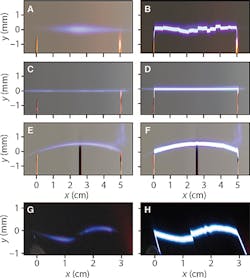Laser beams move closer to controlling the path of lightning
IMAGE: Different shapes of discharge are achieved based on the type of beam used. Images A and B: Gaussian beam (control); C and D: Bessel beam; E and F: Airy beam; G and H: S-shaped beam obtained by combining two conventional Airy beams. Left: Photographs taken when no voltage is applied (only the laser beam is visible). Right: Discharge in the presence of high voltage between the two electrodes. (Image credit: INRS)
Research conducted at the Advanced Laser Light Source facility of the INRS Énergie Matériaux Télécommunications research centre (Varennes, QC, Canada)published in Science Advances details a much-improved method for potentially controlling the path of lightning using lasers.
RELATED ARTICLE: Dual femtosecond-laser-beam setup could divert lightning strikes
Electric arcs have long been used in such technologies as combustion engines, pollution control applications, lighting, machining, and micromachining. Potential applications could multiply with the ability to precisely control the path they take. A first step in this direction has been made and research into the new possibilities and parameters for guiding electric arcs promises to spark researchers’ creativity.
Recent scientific and technical advances, as well as the ingenuity of professor Morandotti’s team at INRS (particularly researcher Matteo Clerici, a postdoctoral fellow with the research group at the time of the experiments), set the stage for this spectacular demonstration, where we see an electric charge follow a smooth path along a straight or parabolic trajectory.
Experimental figures show how different shaped lasers give discharges distinct properties and trajectories. By combining beams, it is even possible to achieve an S-shaped trajectory, with all other kinds of trajectory achievable in principle.
In his bold quest for knowledge, Professor Morandotti wanted to determine whether the self-healing properties of certain shapes of laser beams (such as Airy beams and Bessel beams) could be put to use in these new experiments. This attribute means that a laser beam whose intensity peak is blocked by an obstacle can reconstruct itself once past the object. Professor Morandotti’s team placed an object between the two electrodes and observed that the discharge leapt over the obstacle, without damaging it, and returned to its laser guide on the other side.
"Our fascination with lightning and electric arcs aside, this scientific discovery holds out significant potential and opens up new fields of research," said Yves Bégin, vice dean of research and academic affairs at INRS. "This spectacular proof of concept, which was conducted over a distance of a few centimetres, required the high-power lasers, state-of-the-art facilities, and extraordinary research environment that our professors helped to create at INRS. Being able to work in such cutting-edge labs enables our students and postdoctoral fellows to embark on the path of scientific discovery even while still in school."
SOURCE: INRS; http://www.inrs.ca/english/actualites/could-we-control-path-lightning
